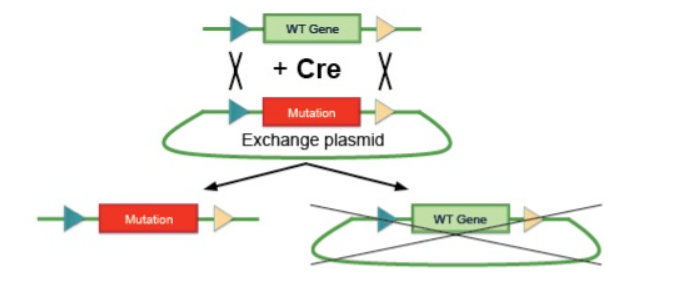Recombinase-mediated cassette exchange (RMCE) technology enables the swapping of large genomic regions. This technology is mainly recommended for the generation of humanized models and several mutants using the same parental ES cell clone.
RMCE technology allows the substitution of large genomic regions in the mouse genome with the concomitant human genomic regions. RMCE can be easily adapted specifically for the generation of humanized models using genomic DNA. With such an approach, a gene of interest and its promoter could be readily humanized in order to reproduce a human expression pattern in the mouse. By using genomic DNA, all human isoforms can theoretically be expressed.
Replacement of a large mouse segment by a human sequence: H.A. Wallace et al. Cell 2006. Manipulating the Mouse Genome to Engineer Precise Functional Syntenic Replacements with Human Sequence.
By using RMCE technology, genOway can insert a mutation into a parental ES cell clone. Using the same parental cell clone, we can then readily generate other mutant models, ultimately saving the client time and money.
With this approach, researchers can compare several mutations by using different targeting vectors in the same parental ES cell clone. These unique mutant cell lines may then be used to create unique mutant mouse lines. Because multiple mutant cell and mouse lines can be created from one parental ES clonal line, RMCE is cost effective and reliable. In addition, RMCE has great potential to allow researchers to comparatively analyze mutants, characterize domain-specific functions in proteins of interest, generate point mutations, generate large gene mutations, and generate entire replacements of a wildtype gene with a different gene of interest. In addition, when researchers utilize the same parental ES clonal line, they are able to conduct studies across multiple Knockin models and between different Knockin models.
Replacement of a mouse gene by human variants at high efficiency: C.M. Chen et al. PLoS One 2012. Functional Significance of SRJ Domain Mutations in CITED2.
RMCE is quicker and safer than homologous recombination
RMCE specifically targets exchanges between two genes
RMCE technology can humanize loci by exchanging the mouse gene with the orthologous human gene
RMCE technology is based on generating a parental ES cell line engineered with a transgene that is flanked by specific recombinase sites (e.g., loxP, lox511)). genOway may then creates an exchange plasmid containing a second transgene (also flanked by specific recombinase sites). The exchange plasmid + transgene are transfected into the parental ES line in the presence of a helper plasmid that expresses recombinase (e.g., Cre). The recombinase catalyzes an exchange between the first ES cell transgene and the exchange plasmid transgene, thus completing the desired gene transfer.
